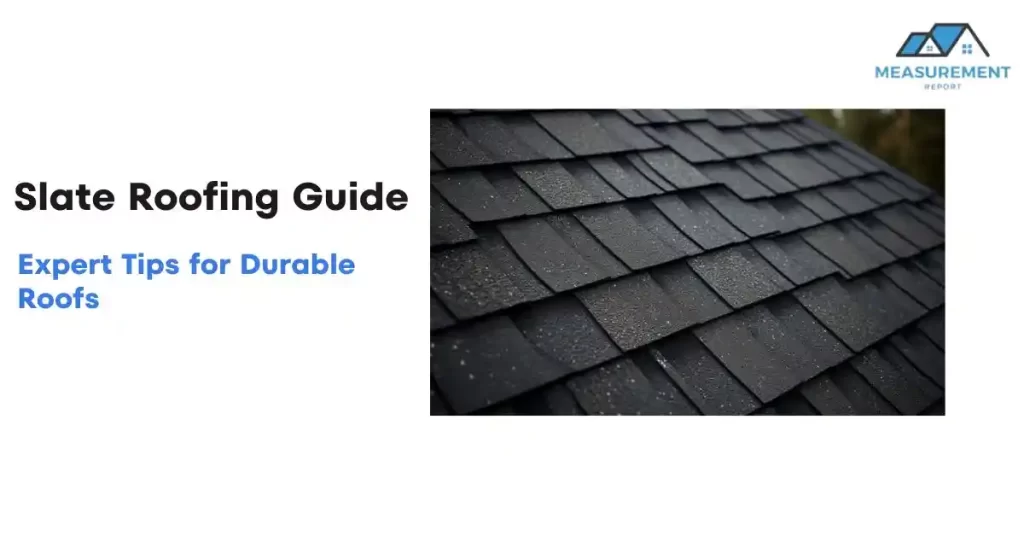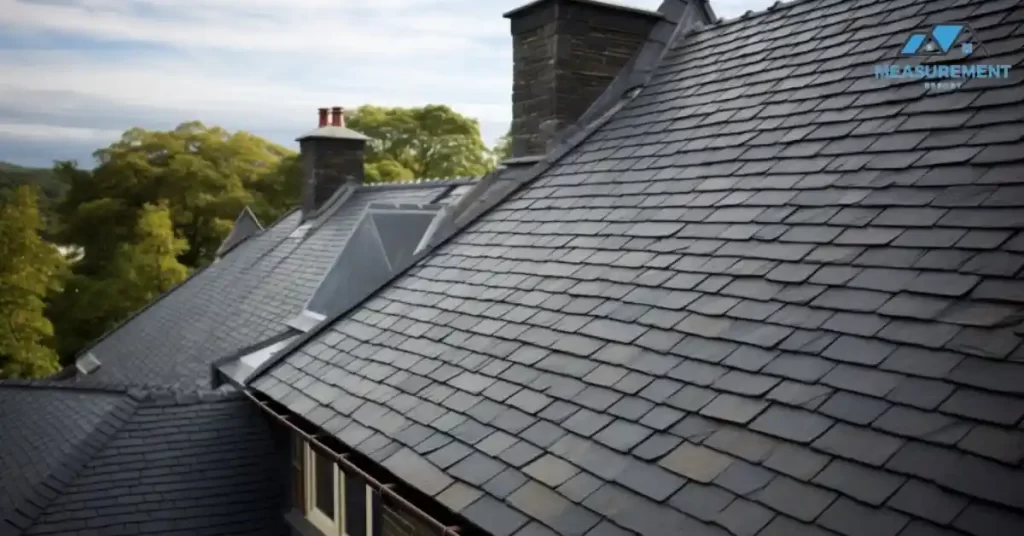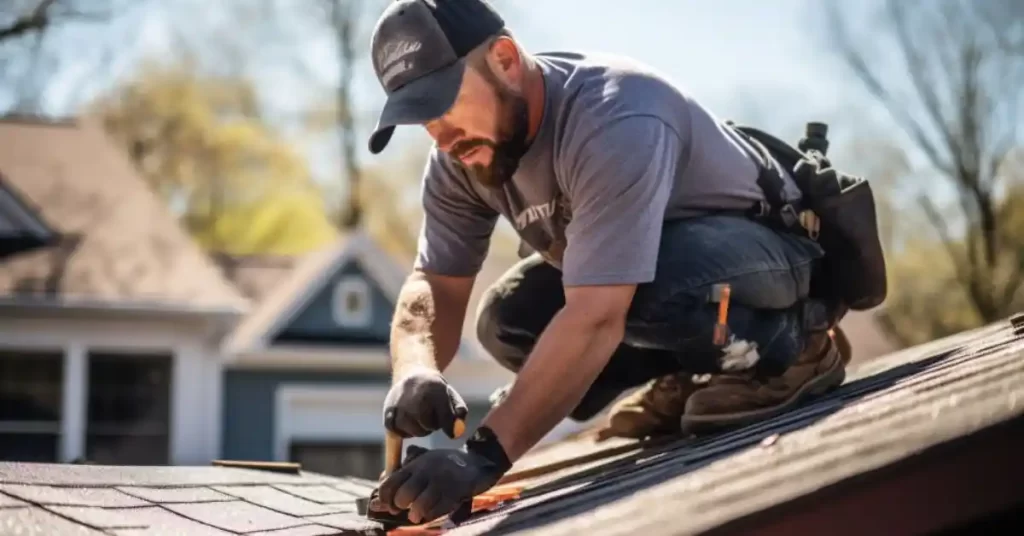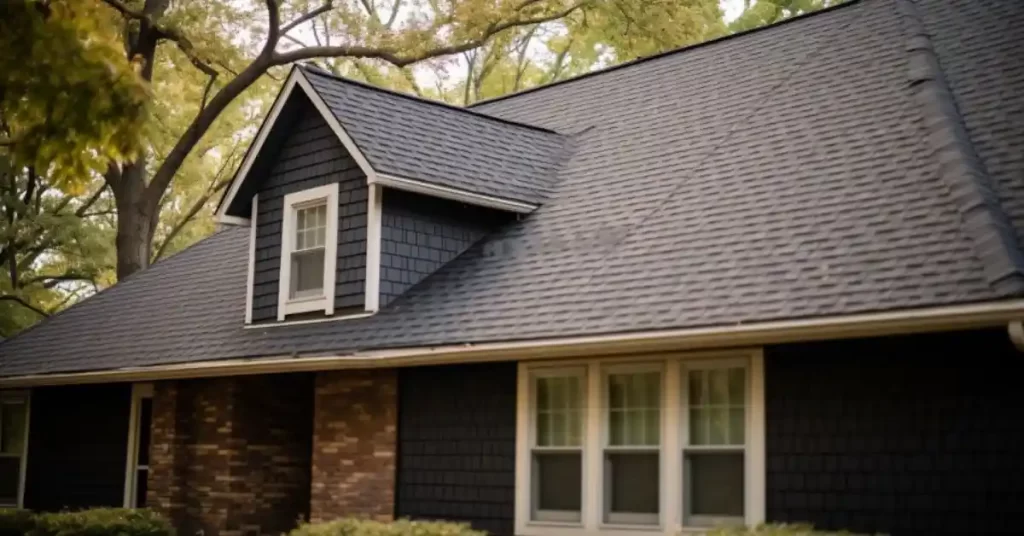The Ultimate Guide to Slate Roofing: Benefits, Installation, and Maintenance

In the realm of architectural elegance and endurance, slate roofing emerges as a paragon of sophistication and practicality. Renowned for its natural beauty and remarkable longevity, slate roofing is not just a choice but a statement, reflecting a blend of tradition and durability. This guide aims to unfold the layers behind the allure of slate roofs, highlighting their key benefits, which range from environmental sustainability to unmatched durability. As we journey through the nuances of slate roofing, we’ll explore its installation, maintenance, and the essential considerations for homeowners contemplating this timeless roofing option. This comprehensive exploration is designed to arm you with all the knowledge needed to understand why slate roofing could be the crowning glory of your home.
What is Slate Roofing?
Slate roofing is more than just a covering for your home; it’s a testament to history’s architectural resilience and natural elegance. At its core, slate roofing involves the use of slate, a fine-grained, foliated metamorphic rock, known for its durability and natural beauty, as the primary material for shingles or tiles on roofs. This form of roofing has been a staple in building construction for centuries, owing to its ability to withstand the elements with remarkable grace and longevity.
Tracing its origins back to historical times, slate roofing holds a significant place in architectural history. It began as a hallmark of high-end construction, often seen gracing castles, churches, and the homes of the affluent. In areas where slate was readily available, it became a material of choice due to its practical qualities and aesthetic versatility. The history of slate roofing is not just a tale of a building material, but a narrative that intertwines with the evolution of architectural styles and techniques, reflecting the changing tastes and technological advancements through the ages.
As we delve deeper into the world of slate roofing, we uncover a legacy that combines natural beauty with a testament to human ingenuity and craftsmanship.
Types of Slate Roofing Materials
When considering slate for roofing, it’s crucial to understand the two primary types available: natural and synthetic. Each comes with its unique characteristics, advantages, and drawbacks, making the choice dependent on various factors, including aesthetics, budget, and environmental considerations.
Natural Slate

Natural slate is quarried from the earth, formed over hundreds of millions of years. It’s renowned for its unique texture, color variations, and long-lasting durability. No two pieces of natural slate are identical, which adds a distinctive charm to each roof.
Pros:
- Longevity: Natural slate roofs can last over a century, often outliving the buildings they cover.
- Aesthetic Appeal: With a range of natural colors and textures, natural slate adds a timeless elegance to any structure.
- Fire Resistance: Being a stone, slate is naturally fire-resistant.
- Eco-Friendly: As a natural material, slate is environmentally friendly and can be recycled.
Cons:
- Cost: Natural slate is one of the more expensive roofing materials in terms of both materials and installation.
- Weight: Slate is heavy, requiring a reinforced roof structure.
- Installation Complexity: Installing natural slate requires specialized skills, making it essential to find an experienced contractor.
Synthetic Slate

Synthetic slate, on the other hand, is a modern innovation designed to mimic the appearance of natural slate but is made from engineered materials such as rubber and plastic. It’s a more affordable and lightweight alternative.
Pros:
- Weight: Synthetic slate is significantly lighter than natural slate, reducing the need for additional structural support.
- Cost-Effective: It’s generally more affordable than natural slate, both in terms of material and installation costs.
- Ease of Installation: Synthetic slate is easier to work with, cutting down on installation time and complexity.
- Durability: Many synthetic slate options are designed to be durable and often come with good warranties.
Cons:
- Lifespan: While durable, synthetic slate typically doesn’t last as long as natural slate.
- Aesthetics: Although it mimics natural slate, the look and feel might not be as authentic.
- Environmental Impact: Being a product of industrial processes, synthetic slate’s environmental footprint is larger compared to natural slate.
The choice between natural and synthetic slate roofing hinges on balancing factors like aesthetics, longevity, environmental impact, and budget. While natural slate offers unmatched authenticity and durability, synthetic slate provides a practical and cost-effective alternative, making slate roofing accessible to a broader range of homeowners. Both types of slate roofing have their unique advantages and limitations, and the decision ultimately depends on the specific needs and preferences of the homeowner.
The Advantages of Slate Roofing
Durability and Longevity
One of the most compelling attributes of slate roofing is its exceptional durability and longevity. Slate roofs are not just a roofing solution; they’re a long-term investment in the stability and resilience of a building. But what exactly contributes to the legendary longevity of a slate roof?
Slate is a natural rock that is inherently sturdy and resistant to the harsh elements that typically wear down other roofing materials. This resilience is one of the primary reasons why slate has been a preferred roofing material for centuries. When properly installed and maintained, a slate roof can last anywhere from 75 to 200 years, making it one of the longest-lasting roofing materials available. This incredible lifespan is significantly longer than that of common roofing materials like asphalt shingles, which typically last around 20 to 30 years.
Factors Contributing to Slate Roof Longevity:
- Natural Composition: As a metamorphic rock, slate is formed under extreme pressure and heat, contributing to its strength.
- Resistance to Weather Elements: Slate is highly resistant to wind, rain, snow, and temperature fluctuations.
- Low Water Absorption: Its low water absorption rate minimizes the risks of frost damage and leaks.
- Fire Resistance: Unlike many roofing materials, slate is fireproof, adding an extra layer of safety to a building.
Given its durability, a slate roof is an excellent choice for those looking for a “fit and forget” roofing solution. While the initial investment may be higher compared to other materials, the extended lifespan of a slate roof often makes it a more cost-effective option in the long run. Homeowners who choose slate roofing enjoy the peace of mind that comes with a roof that withstands the test of time, often outliving other structural elements of the building.
This exceptional longevity, combined with its natural elegance, makes slate roofing an ideal choice for homeowners looking for a blend of practicality and aesthetic appeal.
Aesthetic Appeal and Color Options
The aesthetic charm of slate roofing extends beyond its timeless elegance; it offers a diverse palette of color choices, allowing homeowners to customize their roofs to complement the architectural style of their homes. The natural beauty of slate brings a level of sophistication and uniqueness to roofing that is hard to match with other materials.
Variety in Color and Texture: Slate is available in a wide range of colors, including shades of gray, green, purple, black, and even red. This variety arises from the mineral and chemical composition of the slate, which differs based on the quarry it’s sourced from. Moreover, the texture of slate can vary from smooth and uniform to more rugged and rustic, providing further customization options.
Visual Appeal and Design Flexibility: The versatility in color and texture of slate roofs allows for a high degree of design flexibility. Whether it’s a modern, minimalist structure or a traditional, historical building, there’s a slate option that can enhance the overall aesthetics. This flexibility is particularly beneficial for those looking to maintain the historical integrity of their homes or for designers aiming to create a specific architectural look.
Unique Character Over Time: An interesting aspect of slate roofing is its ability to develop a unique character over time. Some types of slate may change color slightly when exposed to the elements, adding a distinctive patina that can enhance the building’s character. This evolving beauty is a quality that many homeowners appreciate, as it allows the roof to become a living part of the home’s history.
Complementing the Building’s Architecture: When choosing slate roof color options, it’s important to consider the building’s overall color scheme and architectural style. A well-chosen slate roof can bring out the best in a home’s façade, highlighting architectural details and contributing to curb appeal.
In conclusion, the aesthetic appeal of slate roofing is one of its most compelling advantages. With a wide array of color choices and textures available, slate offers an opportunity to not just protect your home but to also enhance its architectural beauty. This, combined with its natural durability, makes slate an excellent choice for homeowners who value both aesthetics and functionality in their roofing choices.
Environmental Benefits
In an era where environmental consciousness is paramount, slate roofing stands out for its eco-friendly aspects, making it a sustainable choice for homeowners. The environmental benefits of slate roofing are significant, aligning with the increasing demand for green building materials and practices.
Natural and Sustainable Material: Slate is a natural stone product, formed over centuries in the earth. It is extracted with minimal processing, unlike many other roofing materials that require significant industrial processing and chemicals. This natural composition means slate has a lower environmental impact during its production phase.
Longevity Reduces Waste: The extraordinary longevity of slate roofs contributes significantly to their environmental friendliness. Because they can last for over a century, the need for frequent replacements is greatly reduced. This longevity means less material waste over time compared to roofing materials that need to be replaced every 20 to 30 years. Fewer replacements also mean reduced consumption of raw materials and less accumulation of old roofing materials in landfills.
Energy Efficiency: Slate’s density makes it an excellent insulator. It helps in maintaining a consistent temperature inside the home, reducing the need for excessive heating in the winter and cooling in the summer. This natural insulation property can lead to lower energy bills and a reduced carbon footprint.
Recyclability: At the end of its life on a roof, slate can be recycled. It can be repurposed for various uses, such as flooring or landscaping, thereby reducing the environmental impact of disposal. The ability to recycle and reuse slate contributes to a circular economy, where materials are kept in use for as long as possible.
Reduced Transportation Footprint: Since slate is a dense material, more of it can be transported in a single shipment compared to lighter materials. This efficiency can lead to a reduction in the carbon emissions associated with transportation.
In conclusion, slate roofing embodies the principles of eco-friendly roofing. Its natural composition, durability, energy efficiency, and recyclability make it an environmentally responsible choice for homeowners. By choosing slate, homeowners are not only investing in a roof that lasts but also contributing to a more sustainable future.
The Importance of Professional Installation
The installation of a slate roof is a complex process that underscores the need for specialized expertise, particularly given the unique characteristics and requirements of slate as a roofing material. This demand for professional skill is not just a recommendation but a necessity, emphasizing the intricate nature of working with slate.
Necessity of Specialized Skills and Knowledge: Slate roofing installation is markedly different from other types of roofing. It requires a specific set of skills and a deep understanding of the material. Professionals in this field are not just roofers; they are craftsmen with detailed knowledge about slate’s properties, including its weight, thickness variations, and the best practices for laying it effectively and aesthetically.
Challenges in Handling and Installation: Slate tiles are heavy and require careful handling to prevent breakage. Their installation demands precision – each tile must be properly aligned and secured to prevent future leaks or damage. A professional slate roofer knows how to manage these challenges, ensuring each piece of slate is installed with the utmost care and attention to detail.
Importance of Proper Installation for Longevity: The longevity and durability of a slate roof heavily depend on the quality of its installation. A poorly installed slate roof can lead to numerous problems, such as water infiltration, loose tiles, and even structural damage over time. Expert installers ensure that the roof is not only aesthetically pleasing but also structurally sound and watertight.
Customization and Problem-Solving: Professional slate roofers bring the ability to customize the installation to the specific needs of your home. They can address unique architectural features, varying roof pitches, and other nuances. Their experience also allows them to foresee and solve potential problems before they become major issues.
In summary, the installation of a slate roof is a task that demands special installation expertise. This expertise ensures that all the benefits of slate roofing – its beauty, durability, and eco-friendliness – are fully realized. By entrusting this task to seasoned professionals, homeowners can ensure that their investment is sound and that their slate roof will stand the test of time, weather, and aesthetic trends.
Cost Analysis

When considering slate roofing, one of the most critical aspects for homeowners is understanding the costs involved. The investment in a slate roof is significant, and a comprehensive breakdown of expenses is essential for informed decision-making. The focus on “Slate roof cost per square foot” provides a clear framework for this financial analysis.
Initial Material Costs:
- Natural Slate: The cost of natural slate tiles can vary significantly based on the quality, thickness, and origin of the slate. On average, homeowners can expect to pay a premium price per square foot for high-quality natural slate.
- Synthetic Slate: Generally more affordable than natural slate, synthetic slate offers a cost-effective alternative. However, prices can vary depending on the brand and quality.
Installation Costs:
- The installation of slate roofing is labor-intensive and requires specialized skills. This is often reflected in higher labor costs compared to other roofing materials. The exact cost can vary based on the complexity of the roof design, the location of the property, and the expertise of the contractor.
Additional Structural Support:
- Due to its weight, natural slate may require additional structural support. This can add to the overall cost, especially if the existing structure needs significant reinforcement.
Longevity and Lifetime Value:
- While the upfront costs of a slate roof are higher, it’s important to consider the long-term value. The durability and longevity of slate roofing can make it a more cost-effective option over time, as it requires fewer replacements compared to other roofing materials.
Maintenance Costs:
- Slate roofs are relatively low-maintenance, but occasional repairs may be needed, such as replacing broken tiles. The cost of maintenance should be factored into the overall financial consideration.
In summary, the cost of a slate roof per square foot encompasses not just the immediate expenses of materials and installation but also long-term considerations like maintenance and potential structural adjustments. While the initial investment is significant, the durability and aesthetic appeal of slate roofing, coupled with its minimal maintenance requirements, often justify the cost for homeowners looking for a long-lasting and beautiful roofing solution.
Comparing Slate Roofing with Other Materials
When homeowners consider re-roofing, a common comparison is between slate and more conventional materials like asphalt shingles. This comparison, often framed as “Slate vs. Asphalt,” is crucial in understanding the value proposition of each roofing type.
Slate Roofing:
- Durability and Longevity: Slate’s longevity is unmatched, often lasting over a century, whereas asphalt shingles typically last around 20 to 30 years.
- Aesthetic Appeal: Slate offers a unique and elegant appearance with a variety of natural color options, which is hard to replicate with asphalt.
- Environmental Impact: Being a natural stone, slate is more eco-friendly. Its longevity also means less frequent replacement and reduced waste.
- Cost: The initial cost of slate roofing is considerably higher than asphalt, both in terms of materials and installation.
Asphalt Shingles:
- Cost-Effectiveness: Asphalt shingles are much more affordable upfront compared to slate. This makes them a popular choice for homeowners with budget constraints.
- Ease of Installation and Repair: Asphalt shingles are lighter and easier to install and repair, which can translate into lower labor costs.
- Variety: They come in various colors and styles, although they lack the natural look and feel of slate.
- Lifespan and Sustainability: Asphalt shingles have a shorter lifespan and are less sustainable. They are made from petroleum products and are not as eco-friendly.
Key Considerations:
- Long-Term Investment: For homeowners who plan to stay in their homes long-term, slate can be a more cost-effective choice due to its durability.
- Budget Constraints: If immediate costs are a concern, asphalt shingles might be the more viable option.
- Aesthetic Preferences: For those valuing aesthetics and historical authenticity, slate is unparalleled.
- Environmental Considerations: Eco-conscious homeowners might prefer slate due to its natural composition and sustainability.
In conclusion, the choice between slate and asphalt shingles hinges on various factors, including budget, aesthetic preferences, long-term plans for the property, and environmental considerations. While slate represents a higher initial investment, its durability, aesthetic appeal, and environmental benefits make it a worthy consideration for homeowners who prioritize these factors. Conversely, asphalt shingles offer an affordable, versatile, and practical solution for roofing needs with shorter-term considerations.
Maintenance and Long-Term Care
How to Maintain a Slate Roof
Proper maintenance is key to maximizing the lifespan and preserving the beauty of a slate roof. Despite its durability, slate roofing still requires periodic attention to ensure its longevity. This section serves as a “Slate roof maintenance guide,” offering practical advice to homeowners.
Regular Inspections:
- Conduct regular inspections of your slate roof, ideally twice a year or after severe weather events. Look for cracked, broken, or missing slates. Early detection of these issues can prevent more significant problems down the line.
Dealing with Moss and Lichen:
- Slate roofs can be prone to the growth of moss and lichen, especially in shaded or moist environments. While these do not typically harm the slate, they can trap moisture and potentially lead to damage. Gentle cleaning methods, avoiding harsh chemicals or pressure washing, can be effective.
Gutter Maintenance:
- Keep gutters and downspouts clean and clear of debris. Clogged gutters can cause water to back up and potentially damage the roof structure, including the slate tiles.
Avoid Walking on the Roof:
- Slate tiles can be brittle underfoot. Avoid walking on them unless absolutely necessary. If roof access is required, use a professional who knows how to distribute weight evenly to avoid breaking tiles.
Replacing Damaged Slates:
- If you find damaged or missing slates, it’s important to replace them promptly. Use the services of a professional who specializes in slate roofs to ensure a proper match and installation.
Flashings and Sealants:
- Regularly check the flashings around chimneys, vents, and other roof penetrations. Faulty flashings can lead to leaks, which are a primary concern for any roof. Ensure they are intact and sealed properly.
Avoid Improper Additions:
- Be cautious about adding new elements to your roof, like solar panels or satellite dishes. These additions should be installed carefully, considering the fragile nature of slate tiles.
In summary, while slate roofing is low-maintenance compared to other roofing materials, adhering to a maintenance guide ensures that it remains in excellent condition for decades. Regular inspections, gentle cleaning, proper gutter maintenance, and professional repairs are crucial steps in preserving the integrity and beauty of a slate roof. With the right care, a slate roof can be a lasting and beautiful asset to any home.
Repairing a Slate Roof

A common question among homeowners with slate roofing is whether a slate roof can be effectively repaired. The answer is a resounding yes. Slate roof repair is not only possible but also a critical aspect of maintaining the integrity and longevity of the roof. Understanding the nuances of slate roof repair is essential for ensuring that minor damages don’t escalate into major issues.
Identifying the Need for Repairs:
- The first step in slate roof repair is identifying any damaged, cracked, or missing slates. Regular inspections play a key role in this process. Signs that repair may be needed include visible cracks in the slates, missing tiles, and evidence of leaks in the attic or upper floors of the home.
Repair vs. Replacement:
- Not all damages necessitate a complete roof replacement. Many issues with slate roofs can be resolved by replacing individual slates. This selective replacement can be a cost-effective way to extend the roof’s lifespan.
Professional Assessment:
- Given the specialized nature of slate roofing, it’s advisable to have a professional assess the condition of the roof. They can determine the extent of the damage and recommend the appropriate course of action.
Using the Right Materials:
- When repairing a slate roof, it’s crucial to use slates that match the existing roof in terms of size, thickness, and color. This ensures a uniform appearance and maintains the roof’s structural integrity.
Specialized Techniques:
- Repairing a slate roof requires specific techniques and tools. Professionals skilled in slate roofing will use appropriate methods to remove damaged slates and install new ones without damaging surrounding tiles.
Addressing Underlying Issues:
- It’s important to address not just the visible damage but also any underlying issues that may have caused it. This includes checking the roof’s flashing, underlayment, and fastening system.
Long-Term Care:
- Post-repair, ongoing maintenance is key. Regular inspections and addressing minor issues promptly can prevent future extensive repairs.
Slate roof repair is a feasible and often necessary aspect of owning a slate roof. With the right approach, materials, and professional expertise, repairs can effectively extend the life of a slate roof, preserving its beauty and functionality for years to come. Homeowners should embrace the idea that while slate is durable, periodic repairs are part of its long-term care.
Is Slate Roofing Right for Your Home?
Choosing the right roofing material is a significant decision for any homeowner. When considering slate, the question often arises: “Is slate roofing suitable for all climates?” Understanding the compatibility of slate roofing with various factors such as climate, home structure, and personal preferences is crucial in making an informed decision.
Climate Considerations:
- Cold Climates: Slate performs exceptionally well in cold climates. Its resistance to frost and low temperatures makes it an ideal choice for regions with harsh winters.
- Wet Climates: Slate’s low water absorption rate makes it resistant to water damage and mold growth, which is beneficial in wet climates.
- Sunny and Hot Climates: While slate can withstand heat, it’s important to consider its dark color which can absorb heat. In extremely hot climates, this could potentially lead to higher cooling costs.
Structural Requirements:
- Weight: Slate is a heavy material, and not all structures are equipped to support its weight. It’s essential to have a structural assessment of your home to determine if additional support is needed.
- Roof Pitch and Design: Slate roofing is suitable for a range of roof pitches and designs, but certain complex roof shapes might require more specialized installation.
Aesthetic and Architectural Fit:
- Historical and Traditional Homes: Slate is often the preferred choice for historical homes due to its traditional and timeless appearance.
- Modern Homes: While typically associated with traditional designs, slate can also complement modern homes, especially with the variety of colors and finishes available.
Long-Term Considerations:
- Resale Value: A slate roof can enhance the resale value of a home, as it is often seen as a luxurious and long-lasting feature.
- Budget and Investment: Consider if the initial higher investment aligns with your budget and long-term homeownership plans.
Environmental Impact:
- For eco-conscious homeowners, slate’s sustainability and natural composition make it an attractive choice.
While slate roofing is suitable for a wide range of climates and architectural styles, it’s important to consider factors such as your home’s structural capacity, climate specifics, aesthetic preferences, and long-term financial planning. Slate roofing, with its myriad of benefits, can be an excellent choice for many, but it’s crucial to ensure that it aligns with the specific needs and circumstances of your home.
Best Slate Roof Manufacturer
When choosing the best slate roof manufacturer in the USA, several reputable companies stand out for their quality products and services:
- The Roof Tile and Slate Company: Known for its high-quality slate roofing and clay tiles, this company offers an extensive line of new, reclaimed, and antique roofing products. They provide a variety of options, ensuring design requirements are met, whether you’re looking for a rustic handmade appearance or natural slate with varying textures and elegant colors.
- EcoStar LLC: Specializing in sustainable and environmentally friendly roofing products, EcoStar is a leading manufacturer for those looking for eco-friendly options. They offer recycled synthetic alternatives to natural slate roofing, making them a great choice for eco-conscious consumers.
- Greenstone Slate Company: This manufacturer is renowned for its high-quality roofing slate, offering a 100-year warranty on their products. They are known for producing slate with excellent wind tolerance, hail resistance, and fire protection, making them a reliable choice.
- North Country Slate: As a large producer of roofing tiles in North America, North Country Slate’s quarries produce mineral-rich and unique deposits, resulting in rich black slates with smooth textures and an enviable luster.
- Vermont Structural Slate Company: Established in 1859, they are a prestigious manufacturer of natural slate roofing tiles, highly sought by architects due to their durability, flexible designs, and custom sizes and shapes.
Each of these manufacturers offers unique strengths, whether it’s the variety and quality of their slate, their focus on sustainability, or their long-standing reputation in the industry. When selecting a slate roof manufacturer, consider factors such as the specific slate type you need, environmental considerations, and the architectural style of your home.

Conclusion
In conclusion, choosing a slate roof for your home involves considering a range of factors including the aesthetic appeal, durability, environmental impact, cost, and maintenance requirements. Slate roofing, available in both natural and synthetic forms, offers a unique combination of longevity, beauty, and eco-friendliness, making it a standout choice for many homeowners. However, it requires a significant initial investment and specialized installation expertise.
When deciding if slate roofing is right for your home, consider the local climate, your home’s structural capacity, and your long-term living plans. Maintenance, while relatively low compared to other roofing materials, is still crucial to extend the lifespan of a slate roof. In case of repairs, it’s advisable to seek professional help due to the specialized nature of the material.
Finally, choosing the right manufacturer is key to ensuring quality and durability. Companies like The Roof Tile and Slate Company, EcoStar LLC, Greenstone Slate Company, North Country Slate, and Vermont Structural Slate Company are recognized for their excellence in the industry. Each offers unique benefits, whether in terms of product quality, environmental sustainability, or range of options.
Slate roofing, with its timeless appeal and proven performance, is more than just a roofing choice; it’s a long-term investment in your home’s future. As with any significant home improvement decision, thoughtful consideration and expert advice are essential in making the best choice for your specific needs and preferences.
Related Article –
- Optimizing Roof Measurement for Solar Panels: Ultimate Guide
- Mastering Commercial Roof Measurement: Techniques and Tools
- TPO Roofing: Everything You Need to Know
- Ultimate Guide to Roof Flashing: Installation, Types, and Maintenance

Meet William Adams, a seasoned roofing expert with over 30 years of hands-on experience in the industry. Having worked tirelessly under the scorching sun and through the fiercest storms, William brings a wealth of knowledge and expertise to the table. Hailing from the heart of the USA, he’s witnessed the evolution of roofing practices firsthand, mastering every aspect along the way. Now retired from the field, William spends his days cherishing time with his loved ones while sharing his invaluable insights through this platform. With William at the helm, you can trust that every tip, advice, and recommendation provided is backed by years of real-world experience and unwavering dedication to quality craftsmanship. Join us as we journey through the world of roofing, guided by the wisdom and passion of a true industry veteran.
